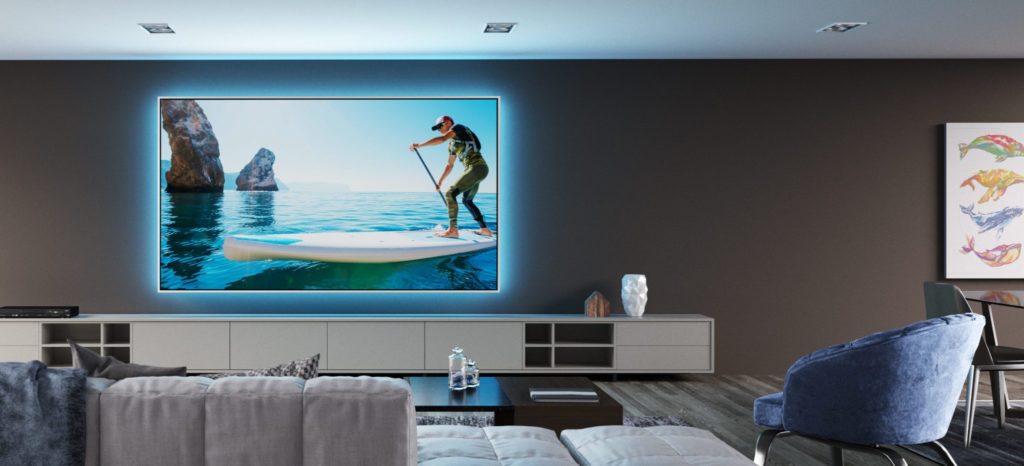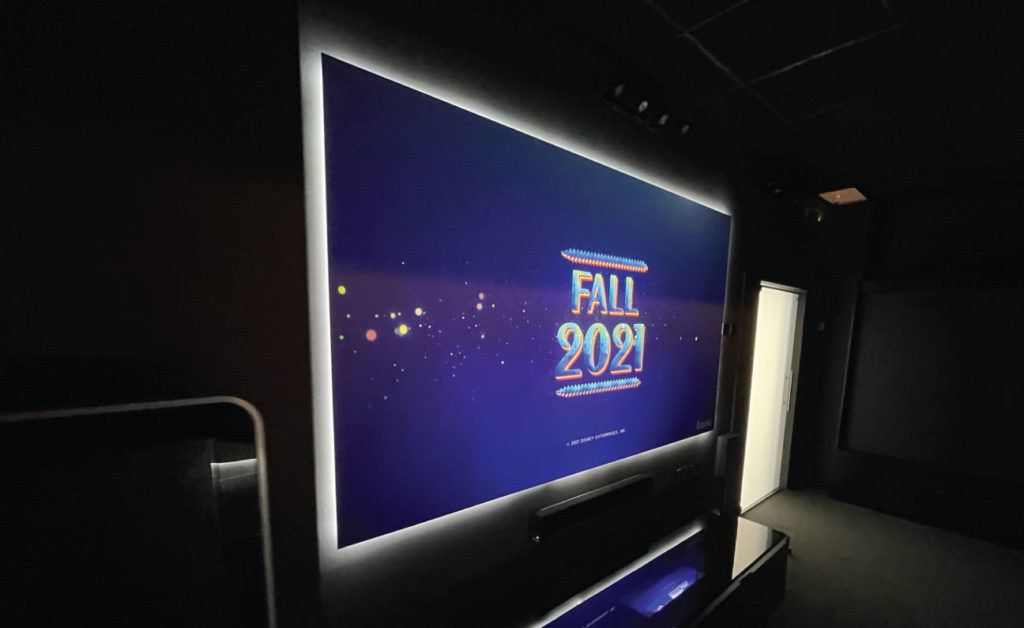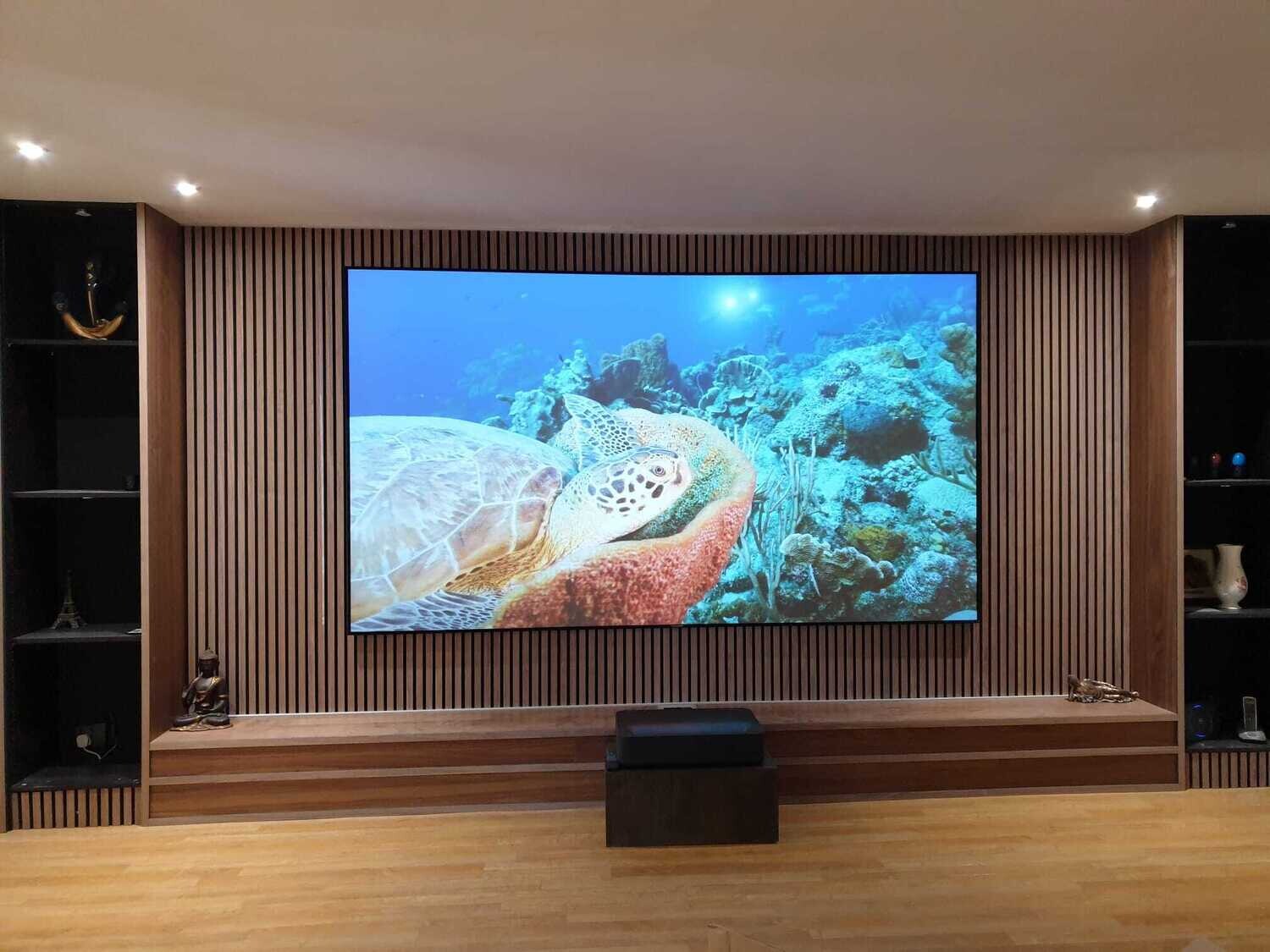Screens that reject ambient light (ALR screen) are different from standard screens in a number of ways.
The most typical screen materials equally reflect the incoming light in all directions.
Diffuse reflectors are the name given to these screen surfaces. Instead of simply one angle, the light is reflected back at several angles. Specular reflectors are surfaces that only return light at one angle; they do this by reflecting light at an angle exactly opposite to the one from which it originally came, like a mirror.
Some projector screens might not be completely diffuse reflectors in that they might reflect light more strongly in one direction than another. This is frequently done to brighten the reflected picture (gain) in a specific area (viewing angle).
How We Tested the Screens
Since these screens are designed for use in ambient light, we evaluated their performance two ways. First we used window light illumination from the side, then we added low-wattage ceiling mounted floods placed above the screens and directed downward. The tests were done in a room with large, north-facing picture windows along one wall. All measurements were taken at mid-day when diffused light from the north sky was at its brightest. The brightest concentration of incoming light from the windows was striking the screens at a 50 degree angle from center. In addition, the test room has white walls, carpet, and ceiling, so there was plenty of soft indirect reflected ambient light in the environment. In short, this room might be typical of a well-lit residential multipurpose room that you’d want to use for TV viewing or gaming during daylight hours.

After taking luminance, contrast, and half gain measurements under the window light conditions, we added four 20-watt ceiling mounted floods to see how additional light from above the screens would further impact contrast, black levels, and saturation. This light from above was directed onto the screens at a 30 degree angle. This was intended as a torture test to see how the screens respond to light from above. (Hopefully nobody would intentionally direct floods onto a projection screen in a real installation.)
Light-Rejecting Screens’ Benefits
Specular reflection, which is what traditional projection screens rely on, has issues with glare and the “spotlight effect.” Light rejecting screens have improved anti-glare (AG) qualities that diffuse reflection and stop highlighting to address these problems.
Common projection screens also frequently employ flat screens or repetitive optical structures, both of which have significant flaws. Screens with repeating optical structures produce brightness uniformity regions, whereas flat screens reflect a large portion of the main projected light upwards towards the ceiling, resulting in lower brightness and poor image quality.
A single design solution is unable to solve the challenges of uneven brightness uniformity since different projection angles exacerbate the issues mentioned above. Only an adaptable design and light-rejecting materials can successfully transmit light to the observer.
Differences Between ALR and CLR Screens
Ambient Light Rejection screens (ALR) reflect light back to viewers in a controlled fashion, unlike regular screens that reflect less light and do so in all directions. Remember, the more light a screen absorbs, the worse the image quality. ALR screens bounce more light back to viewers, resulting in a brighter and bolder image while more effectively redirecting ambient lighting so that it doesn’t interfere as much with image quality. However, positioning of projectors and room lights still matters, and if both face the screen from the same angle, ALR doesn’t work as well.
CLR or Ceiling Light Rejecting® material is a patented technology from Elite Screens that aims to improve on regular ALR. The material used absorbs up to 95% of incoming light from projectors while negating washout from ambient lighting, especially big ceiling lights. Contrast reaches up to a 100 times that of plain non-reflecting white or grey screens. We recommend matching BenQ laser projectors with the Elite Screen Aeon CLR® 3 Series.
Understanding What ALR Is All About
ALR screens selectively reflect light back to the viewer to make the image brighter than it ordinarily would in other screen types. They achieve this effect by proper projector positioning relative to the screen until the light from the device is bounced towards the viewer or audience. Meanwhile, the ambient light is reflected back in some other direction to keep it from impeding or stealing the thunder of the projected image. This allows projector owners to not turn off lights when watching movies.
The Specifics of Using an ALR Screen: An ALR screen works best when the ambient light isn’t hitting it from the same direction as the projector, so you need to properly place the light, projector, and screen to maximize its effect. Seeing that most projectors are fixed and mounted on the ceiling while the screen is placed relative to the projector, you can adjust things thusly once and only once then have the ALR do its thing, with projector brightness maximized and the ambient light minimized or redirected elsewhere.
What Ambient Light Rejection Is All About: Ambient light makes projector light weaker unless the projector light crosses a certain threshold of brightness in lumens, such as a lamp that’s 2,500 to 3,000 lumens in brightness. Ambient light robs the brightness of your projector light while the lack of light makes projector light relatively stronger and clearer to your eyes in comparison. It’s like when your bright flashlight doesn’t look as bright when used during daytime. ALR, like any good lighting setup, reflects, redirects, and rejects that ambient light while at the same time, through correct viewing angles, the light of the projected image is reflected back to you, the audience.

Great for Conference Rooms: Some users might find this the perfect business projector screen, such that even less-than-bright projectors like mini projectors or camping projectors can work in a conference room or classroom setting with the lights on yet still have a bright image or projection on the screen when push comes to shove. After all, these fabrics are constructed to furnish direction acceptance and return light reflectance within the defined constraints for audience convenience even with lesser projectors that aren’t as bright or safeguarded against ambient light.
The Goal of the ALR Surface: The goal of the ALR surface is to respond excellently or superbly to light from perpendicular sources or orthogonal angles, like from the light of a projector projecting an image or video. It also limits the re-reflection of light coming from off-axis sources, which is also known as ambient light from your in-room light bulbs, lamps, mood lighting, and even daylight from your open windows. It’s a simple concept that works The Laws of Physics into ensuring that you can scientifically make your projector viewing all the more comfortable and viewable. If you have an ultra-short-throw projector, it can get touch to angle it just right to ensure maximum ALR effectiveness compared to ceiling-mounted standard projectors.
Design Considerations: When searching for ALR screens, you should take note of several design considerations. First off, ALR screens work most effectively when the projector’s light and ambient light are coming from different directions. Angle your screen and projector in a way that deflects the ambient light elsewhere while maximizing the reflection of the light from your projector. This is more effective at making projection images brighter than simply upping the lumen count of your projector to fight off the haze-inducing effects of stronger light robbing your weaker light of sharpness.
Location, Angle, and Material: ALR screens use special material to maximize projection light and make images brighter. However, they can only work if you have the proper projector location relative to the viewer or audience as well as the lighting fixtures you have in your room. It rejects ambient light an maximizes reflectivity of the projector light to ensure maximum viewing quality and satisfaction. Keep in mind the location of the projector. ALR screens have unique properties that make it critical to position your display device relative to the screen that’s within the proper projection angle.
Conclusion
it’s abundantly clear that ALR screens have revolutionized the way we enjoy projections. These screens are like our trusty shields against pesky ambient light, ensuring that we experience crystal-clear visuals even in well-lit surroundings. Whether you’re setting up a cozy home theater, an engaging classroom, or a professional boardroom, ALR screens are your dependable allies. With technology marching forward, these screens will continue to be the unsung heroes, making our viewing experiences truly exceptional. So, embrace the brilliance of ALR screens, and watch as your projection setup soars to new heights, delivering nothing short of excellence.




